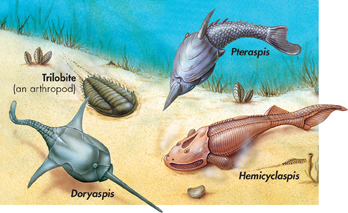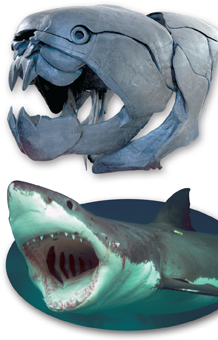
FIGURE 26–6 Ancient Jawless Fishes Ancient jawless fishes, some of which were armored, such as those shown here, lived during the early Devonian Period. Since they lacked jaws, they were limited in their ability to feed and defend themselves. Paired fins, however, gave these fishes control over their movement, and the lineage led to today's hagfishes and lampreys.
Jawless Fishes The earliest fishes appeared in the fossil record during the late Cambrian Period, about 510 million years ago. These odd-looking creatures had no true jaws or teeth, and their skeletons were made of cartilage. During the Ordovician and Silurian periods fishes had a major adaptive radiation. The products of this radiation ruled the seas during the Devonian Period, also called the Age of Fishes. Some armored jawless fishes, such as those in Figure 26–6, became extinct at the end of the Devonian, about 360 million years ago. Two other ancient clades of jawless fishes gave rise to the two clades, sometimes called classes, of modern jawless fishes: lampreys and hagfishes.  DOL•48–DOL•51
DOL•48–DOL•51
Lampreys and hagfishes both lack vertebrae and have notochords as adults. (They do have parts of what could be called a skull, which is one of the reasons they are still classified as vertebrates.) Lampreys are filter feeders as larvae and parasites as adults. Hagfishes have pinkish gray, wormlike bodies, secrete incredible amounts of slime, and tie themselves into knots!
Sharks and Their Relatives Other ancient fishes evolved a revolutionary feeding adaptation: jaws. Jaws hold teeth and muscles, which make it possible to bite and chew plants and other animals.
Early fishes also evolved paired pectoral (anterior) and pelvic (posterior) fins. These fins were attached to limb girdles, which are supporting structures made of cartilage or bone. Paired fins offered more control of body movement, while tail fins and powerful muscles gave greater thrust.
These adaptations launched the adaptive radiation of the class Chondrichthyes (kahn DRIK theez): the sharks, rays, and skates. The Greek word chondros means “cartilage,” the tissue that makes up the skeletons of these “cartilaginous” fishes. There are hundreds of species of modern sharks, skates, and rays, ranging from predatory carnivores, such as the great white shark in Figure 26–7, to shy plankton feeders.
 In Your Notebook How did the evolution of paired fins help early fishes succeed in their environments?
In Your Notebook How did the evolution of paired fins help early fishes succeed in their environments?

FIGURE 26–7 Jaws Though about 360 million years separate Dunkleosteus (fossil, top) and today's great white shark (bottom), you can easily see the important adaptation they have in common—jaws. But Dunkleosteus could have bitten “Jaws” the shark in half! Pose Questions What question would you ask a researcher about Dunkleosteus?
Table of Contents
- Formulas and Equations
- Applying Formulas and Equations
- Mean, Median, and Mode
- Estimation
- Using Measurements in Calculations
- Effects of Measurement Errors
- Accuracy
- Precision
- Comparing Accuracy and Precision
- Significant Figures
- Calculating With Significant Figures
- Scientific Notation
- Calculating With Scientific Notation
- Dimensional Analysis
- Applying Dimensional Analysis




